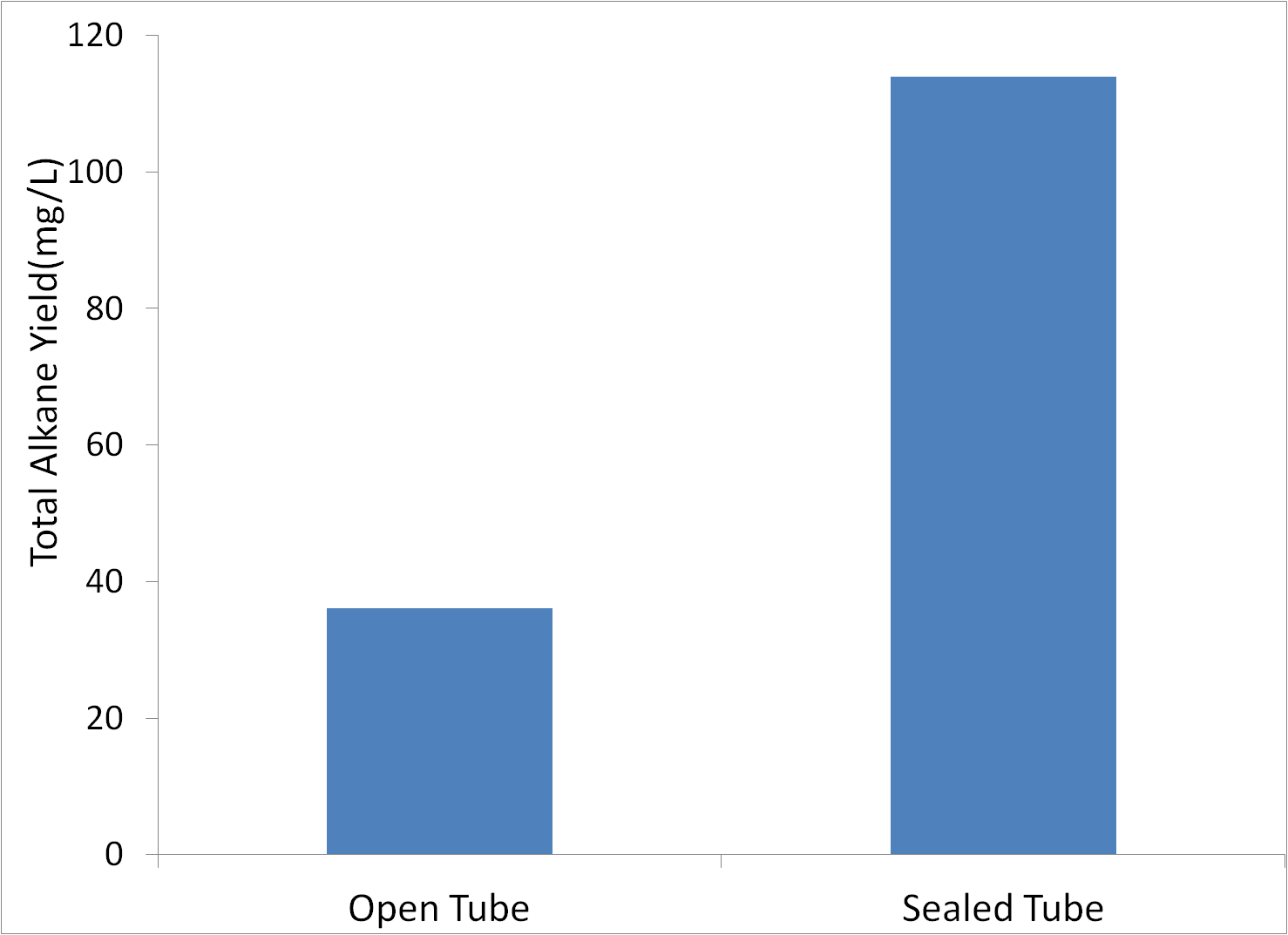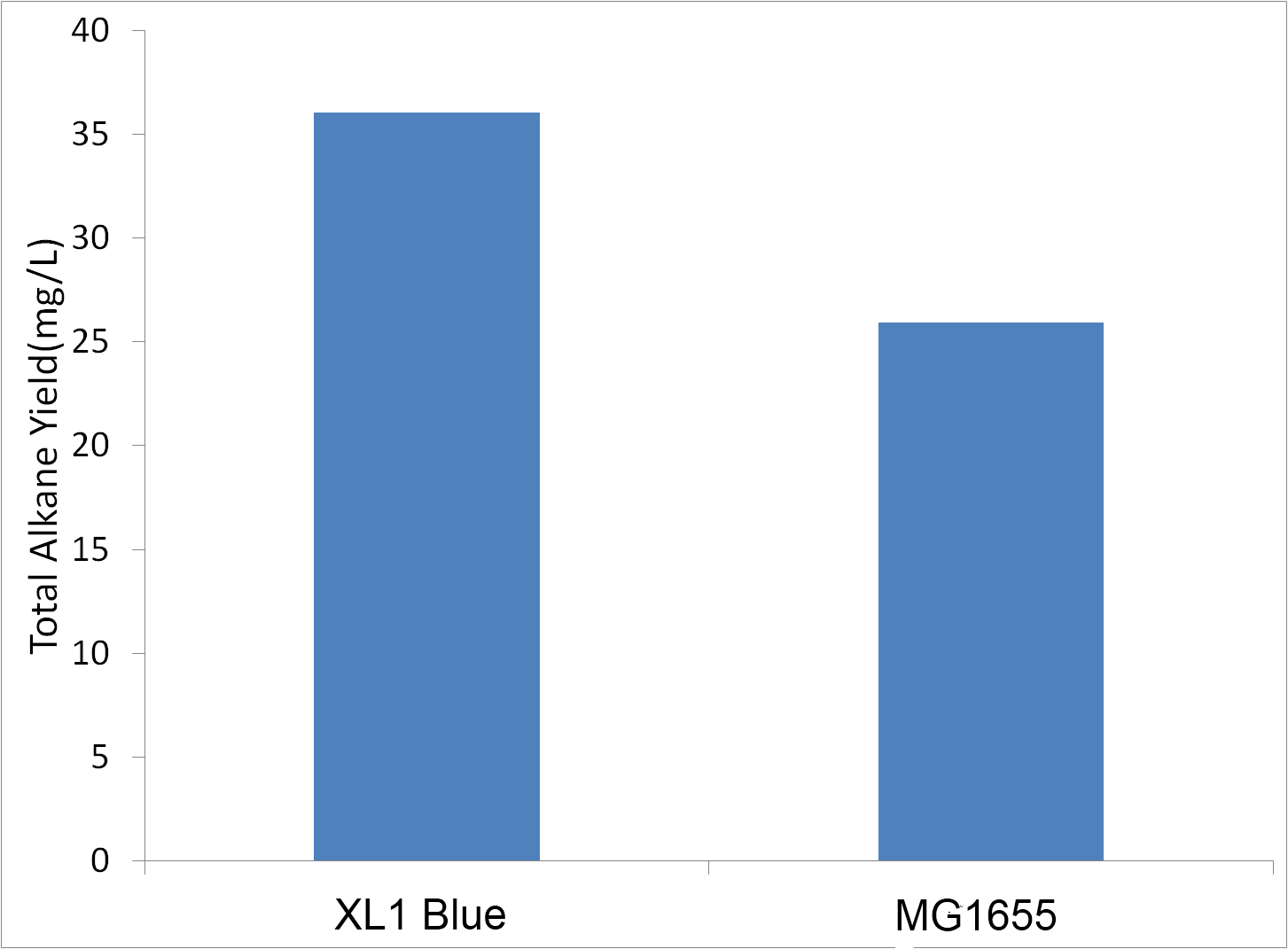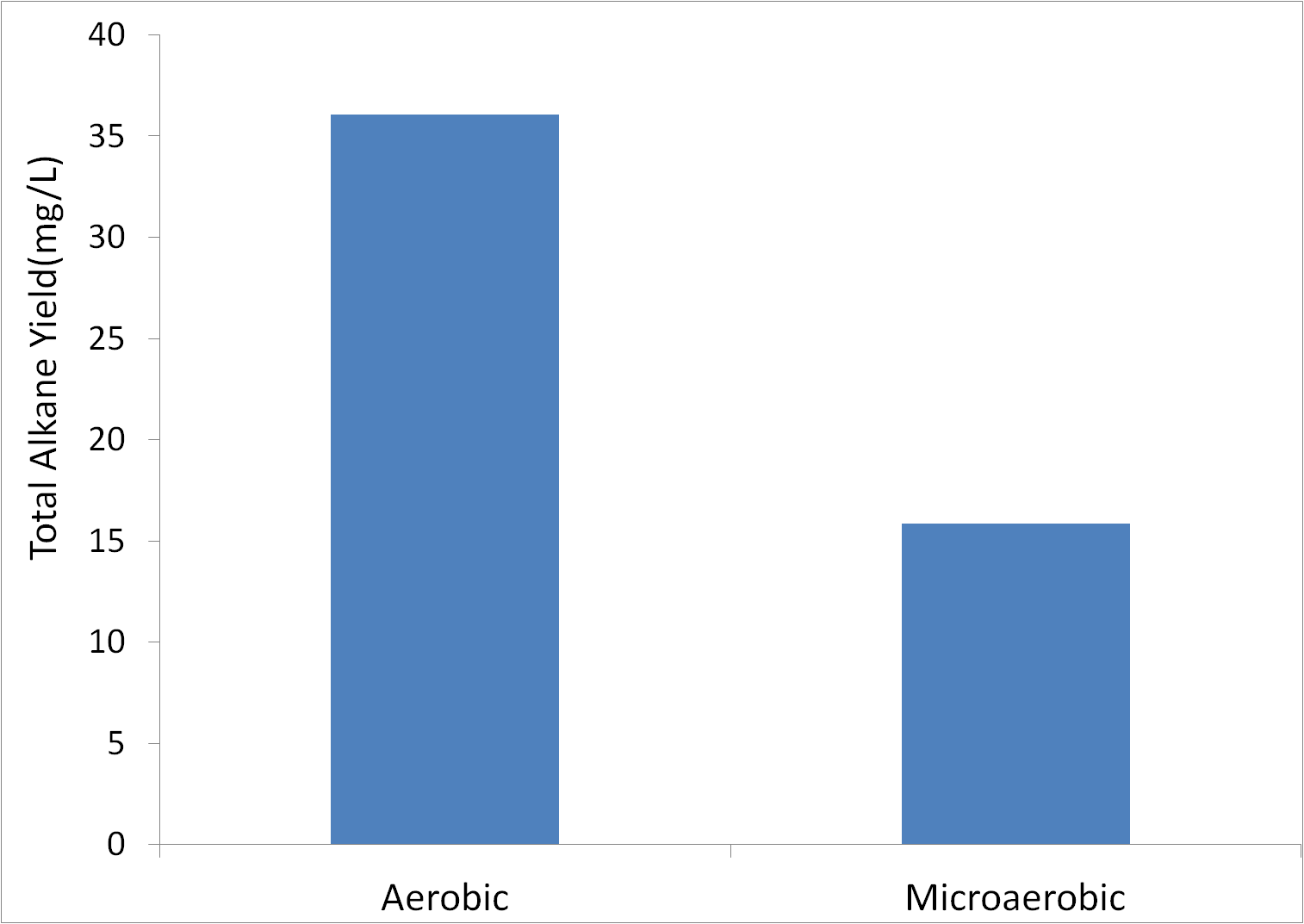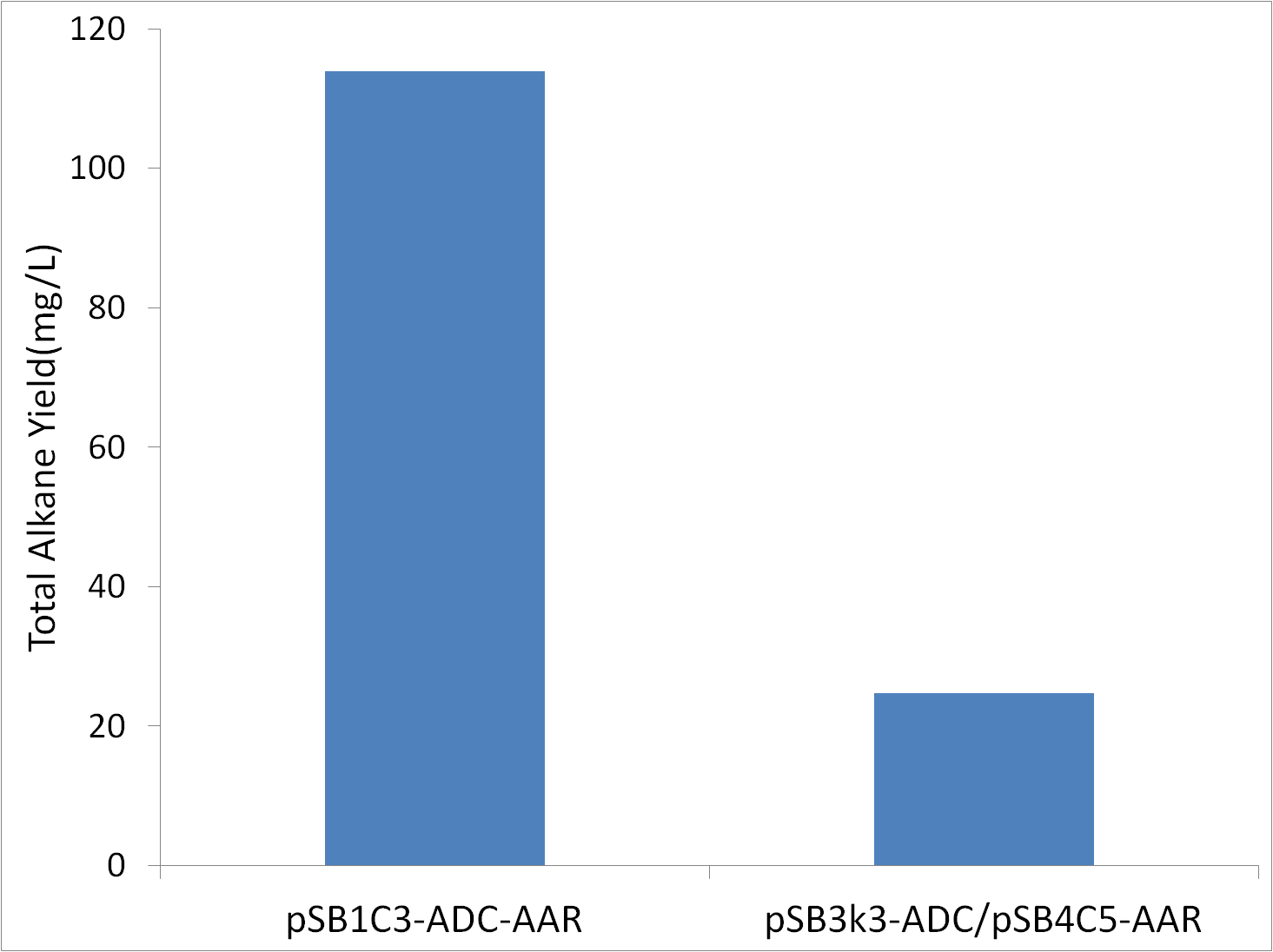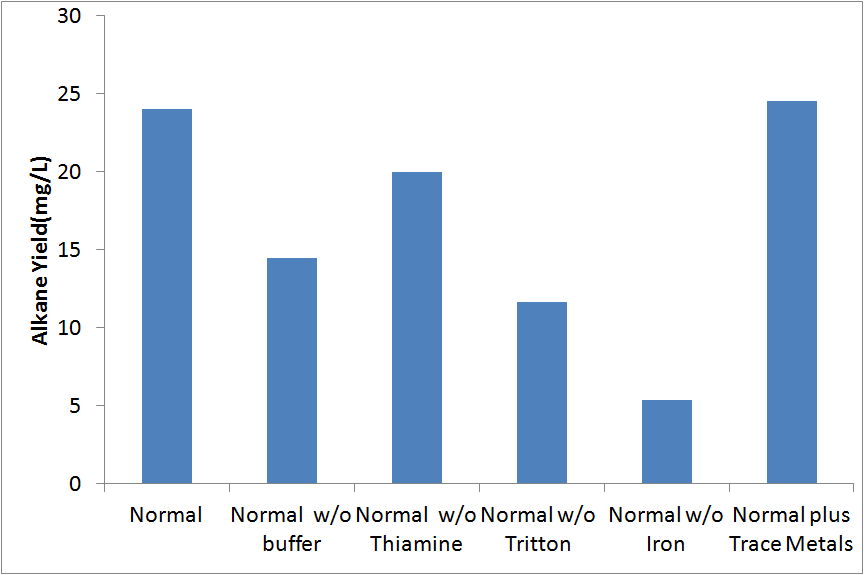Team:Washington/Alkanes/Future/Vector
From 2011.igem.org
(→Effects of Changing Initial Cell Density) |
(→Use of Different Strains) |
||
| Line 12: | Line 12: | ||
=='''Use of Different Strains'''== | =='''Use of Different Strains'''== | ||
| - | We had suspected that different strains of ''E. coli'' would produce varying amounts of | + | We had suspected that different strains of ''E. coli'' would produce varying amounts of alkanes. Initial experiments were done in MG1655, and we decided to test XL-1 blue (a commercial supercopentent variant of DH5a) for the ability to produce alkanes. Tests were conducted in sealed glass culture tubes in M9 production media . Cells were innoculated to an OD600 of 1 when conducting this test. |
[[File:Washinton_XL21vsMG1655.png|center|500px|thumb|XL-1 Blue Produces more Alkane than MG1655]] | [[File:Washinton_XL21vsMG1655.png|center|500px|thumb|XL-1 Blue Produces more Alkane than MG1655]] | ||
| - | XL-1 blue was able to produce more | + | XL-1 blue was able to produce more alkanes than MG1655. Therefore, future tests were conducted in XL-1 Blue. |
=='''Aerobic vs Microaerobic Growth'''== | =='''Aerobic vs Microaerobic Growth'''== | ||
Revision as of 17:06, 25 September 2011
System Optimization
Using our initial, non-optimized growth conditions, we were able to obtain alkane/ene yields of approximately 2 mg/L. In order to make analysis easier, and to make it easier to determine the effects of the addition of additional modules, we wanted to increase yield. Our efforts focused on how by varying system conditions, we could increase yield.
Sealed vs. Open Tubes
We were concerned that alkane evaporation may have been evaporating, reducing apparent yield. Therefore, we performed tests were the tubes were either capped like normal, or capped with foil coverting the opening, reducing evaporation. Tests were conducted in M9 production media, in glass, with MG1655 innoculated to an OD600 of 1.
Covered tubes showed significantly more alkane, so all further tests would be conducted in sealed tubes.
Use of Different Strains
We had suspected that different strains of E. coli would produce varying amounts of alkanes. Initial experiments were done in MG1655, and we decided to test XL-1 blue (a commercial supercopentent variant of DH5a) for the ability to produce alkanes. Tests were conducted in sealed glass culture tubes in M9 production media . Cells were innoculated to an OD600 of 1 when conducting this test.
XL-1 blue was able to produce more alkanes than MG1655. Therefore, future tests were conducted in XL-1 Blue.
Aerobic vs Microaerobic Growth
In many industrial production applications, growth in conditions with little or no oxygen can improve yield. Therefore, we tested alkane yield in cultures grown in airtight vials with only a small amount of air on the top in order to severely limit oxygen availability. Tests were conducted in glass( note that the test was conducted in open culture tubes for aerobic, but sealed glass vials with M9 production media in XL21-blue cells.
Based upon this data, aerobic growth appears to be better for alkane yield. Note that this difference is not likely due to differences in growth rate, as both cultures were inoculated to a high OD600 of 1. The fact that this tube was not covered means that the actual alkane yield( before evaporation) was likely higher. Therefore, microaerobic conditions are unlikely to improve yield.
pSB1C3-ADC-AAR vs pSB3k3-ADC/pSB4C5-AAR
The original study expressed ADC and AAR on seperate low copy number vectors. If we could get high alkane yields using low copy number vectors, the lesser protien and vector production would make the use of a lower copy number vector preferable. Tests were conducted in covered glass culture tubes(aerobic conditions) with M9 production media. Cells were XL1-Blue, and were innoculated to an OD600 of 1.
The fact that high copynumber vector use results in an increase in yield means that high expression levels of ADC and/or AAR are required for high alkane yields.
Media composition
Our initial media was based upon the media used in [1]. We did not know if all of the additional components not found in a normal media (buffer, thiamine, Tritton, iron) actually improved yield. In order to determine if each of these components imporved yield, we analyzed cultures inoculated into M9 medias without each of these 4 compounds. In addition, we tested media with additional trace metals. These tests were conducted in covered glass culture tubes with XL-1 blue cells.
None of the modifications we made resulted in a significant increase in yield. Therefore, no further modifications to the media used was made.
Effects of Changing Initial Cell Density
Earlier tests were done with an initial OD600 of 1. However, we had never established what the optimal initial OD would be. If significant alkane production occurs during stationary phase, inoculation to a high initial OD may increase alkane production. For this test, we inoculated XL-1 blue (to a final OD600 in a range of 0.01 to 10) in M9 production media (in covered glass culture tubes). We extracted from these cultures after 16 hours of growth.
Higher cell density cultures showed significantly higher alkane yields than lower cell density cultures. The increase of alkane yields at cell densities as high as 10 implies that high amounts of alkane production occurs during stationary phase. Therefore, alkane production scales with cell density. In addition, performing alkane production during stationary phase decreases the amount of glucose going towards cellular growth instead of alkane production.
References
Microbial Biosynthesis of Alkanes Andreas Schirmer, Mathew A. Rude, Xuezhi Li, Emanuela Popova and Stephen B. del Cardayre Science 30 July 2010: Vol. 329 no. 5991 pp. 559-562 http://www.sciencemag.org/content/329/5991/559
 "
"



